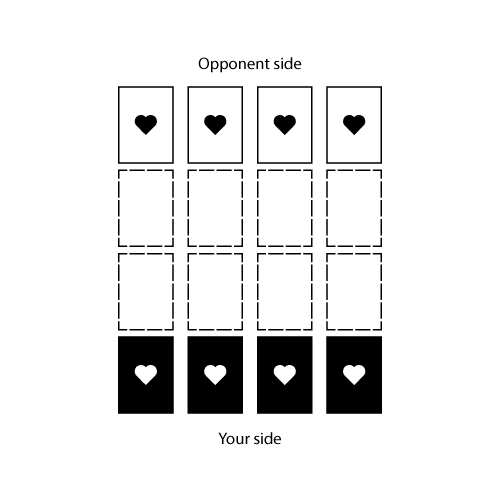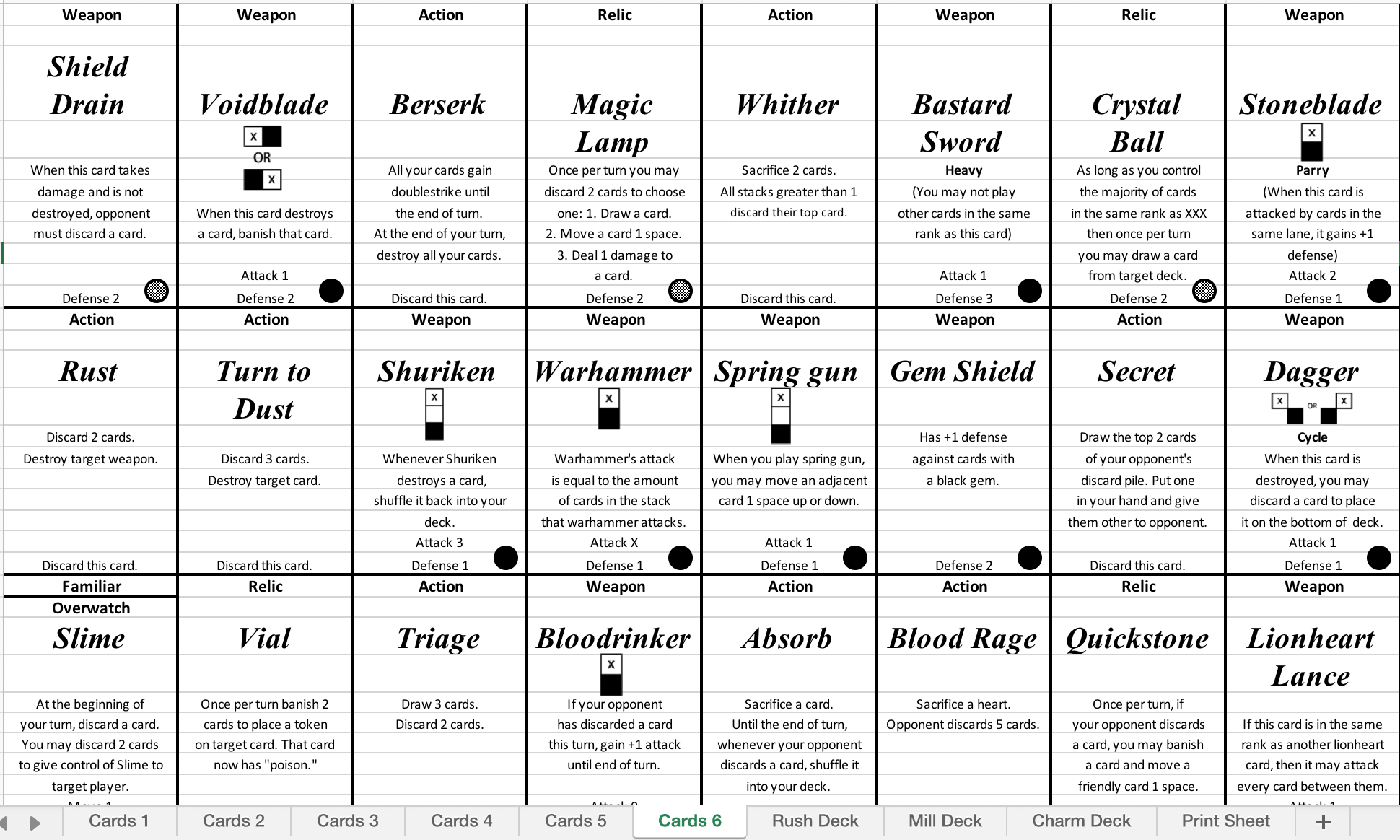Designing Heartbreaker,
My Tactical Card Game
March 1, 2018 boardgames card_games heartbreaker tkg game_design
I’ve been working on a tactical card game called Heartbreaker, for a little over a year now. In it, players each control a dark champion who fight each other to the death on a four-by-four grid with a pre-built deck.
The main challenges I was trying to overcome, were making a game that could be highly competitive, but without requiring a lot of money to play, while still having a high variety of tactics and that wasn’t a deckbuilder. The game draws inspiration from Yomi, Mage Wars, Ascension, Netrunner, and of course, Magic, the Gathering.
I love to play these competitive card games - but I don’t have the time of the money to buy and then customize my decks. Even on Hearthstone, I’m usually just looking up what the best decks are and then spending dust to craft them. This is not super fun to me.
The other big game design inspiration for Heartbreaker is fighting games, like Street Fighter, Guilty Gear, and King of Fighters. I am an awful at these games, but what I like about them is that each character is essentially a toolset of different moves, abilities, and stats (like how big their hitboxes are, how quickly they move or recover from certain moves). You can craft a way you play a certain character around what you like about that character, different characters have different strengths and weaknesses, and the head to head matchups create interesting combinations of those strengths and weaknesses, along with all the various upsets and dramatic tension that comes from seeing any high stakes competitive game.
But you don’t get to customize your character. The character comes pre-built, pre-balanced (you hope). You learn your character. How far they can kick or punch. Who they’re strong against, who they’re weak against. How to read your opponents. And then the super high-level stuff where because both you and your opponent knows what each of your characters’ strengths and weaknesses are, you kind of dance around them, feinting and playing mind games, trying to goad your opponent into playing a move that you can get the upper hand on, one that you can punish.
The lack of customization does not hinder fighting games from being incredibly competitive, addictive, or fun to play.
So most of that isn’t really a game design decision, it’s a business model. After all, I’m basically making an economic argument - buy this game once and you have everything you need to play forever. If we release more characters, more decks, you don’t need them to keep playing. Theoretically a champion with one kind of deck should continue to whomp on players with new and different decks, just through sheer ability, much like a chess champion can pretty consistently beat weaker opponents.
 The Heartbreaker playmat. The top and bottom rows house the “hearts” which each player is trying to destroy. Destroy all your opponent’s hearts, and they’re out of the game.
The Heartbreaker playmat. The top and bottom rows house the “hearts” which each player is trying to destroy. Destroy all your opponent’s hearts, and they’re out of the game.
Basic Gameplay
All in all, I’ve tried to keep the rules in Heartbreaker pretty simple.
Setup
- Setup the playmat per the diagram below.
- Each player draws three cards from their deck.
- Each player may choose to mulligan their hand by discarding 1 card to their discard pile, shuffling their hand into their deck, and drawing 3 new cards. Players can do this as many times as they want.
- The first player does not draw cards on the first turn.
 Basic setup for Heartbreaker.
Basic setup for Heartbreaker.
Objective
Destroy all of your opponent’s hearts to win. If at any point all of your hearts are destroyed, you lose and the game is over. However, each heart has a special ability that can only be used after the heart has been destroyed. Once per turn you may exhaust1 any and all of your destroyed hearts. For each heart you exhaust this way you may either: draw or play a card an extra card.
Turn Order
- Draw Phase: Draw 2 cards at the beginning of your turn. If ever for any reason you are attempting to draw a card and cannot, lose a heart.
- Play phase: You may play up to 2 cards. You may place cards on any unoccupied space, or on top of your own cards. Cards may only be played in one direction, where the text can be read by the card’s owner. Any card may be played facedown. Facedown cards are treated as having 1 defense, meaning an attack of 1 or greater will destroy them. Whenever a facedown card is destroyed, it is first turn face-up to see if it has any effect before being discarded (there are Trap cards that make use of this feature). During this phase, any cards already in play that have abilities (other than attacking) may be used. All facedown cards count as having a colorless “wild gem” for the purposes of casting Spell cards.
- Attack phase: Combat resolves at the end of the turn. Everything that you have that can attack must attack. Only attackers deal damage. The attacker may choose the order in which their cards attack. If their attacker deals more damage than the defender has defense, remove the defender card from the playmat and place it in the discard pile. Any cards not destroyed at the end of the attack phase “heal” back to their full defense at the end of the turn.
Card Types
- Weapons: are the basic card for dealing damage. You place them on the board and you use their icon to determine their range. The black square indicates where the card is played, and then “x” square indicates what card or space it can attack. White squares indicate blank spaces between the two. If a weapon has a higher attack than the defense of the card it’s attacking, then that card is destroyed and sent to its controller’s discard pile.
- Actions: Action cards have an instantaneous effect on the game and then are discarded. You can only play action cards during the play phase on your turn. They do not need to be played in a space, they are simply played to the side, have their effect, and then are discarded.
- Familiars: Familiar cards are powerful creatures that can move around the board, as well sometimes attack or use a special ability. Cards with a move value can move that many spaces in one turn. You can only move during the play phase.
- Relics: Relic cards represent arcane artifacts that have some special ability. They are played on the board and can be destroyed by other cards, much like weapons.
- Traps: Trap cards are unique in that they are always placed face down. While they are face down they operate like any other face down card, meaning that they have no attack and a defense of 1. When they are destroyed, however, they have an effect that goes off immediately before being discarded. Discarding a trap card does not set it off, only destroying it. Sacrificing a trap counts as destroying it. In general, you cannot attack your own traps with your own weapons. But abilities that allow you to target a specific card can.
- Spells: Spells require a special arrangement of “gems.” Gems are shown in the bottom corner of each card. To cast a spell the specified pattern of gems must exist somewhere in the play area. Gems however, can be used from both friendly and opponent cards. Gems connected by a line must be present in the pattern indicated. Gems not connected by a line must just exist somewhere within the player area.
 An example of some Heartbreaker cards. I make them in Excel since it’s easy to quickly change things. But I may move them over to InDesign with data merge soon.
An example of some Heartbreaker cards. I make them in Excel since it’s easy to quickly change things. But I may move them over to InDesign with data merge soon.
In the examples above the tiny grids on some cards with a black square, some white squares, and a square with an “x” show the range of that card’s attack. The circles in the bottom right corners show what color “gem” the card has - which works similarly to mana, in that having your gems organized in a certain way allows you to cast spell cards.
This is basically all there is to heartbreaker from a rules perspective. The rest of the rules are dealt with on the cards themselves. Games consistent of players playing cards down on the playmat in open spaces or on top of their hearts in order to better defend them. You try to control the space on the board so that you can maneuver around your enemy’s cards. You build “stacks” of cards on top of each other to defend your hearts, or use your space more effectively.
Right now I’ve got about six decks built for playtesting. A rushdown deck. A control deck. A mill deck. A charm deck. A defense deck. And a “void” deck. If you’re interested in getting some of the print files to play yourself, let me know!
Flip the card facedown.↩︎
Previous post
Urban Geomorphs for Cyberpunk GamesNull.hack is a cyberpunk RPG that I’ve been working on. You play as a character in a Robocop, Akira, Blade Runner, Neuromancer type world - and less...
Next post
The Hall of Sweet Mourningis a One Page-ish Dungeon. Download it here. Here’s the breakdown: Page One: Map (below) made using Gridmapper (which is...
Copyright © 2018 Failure Tolerated